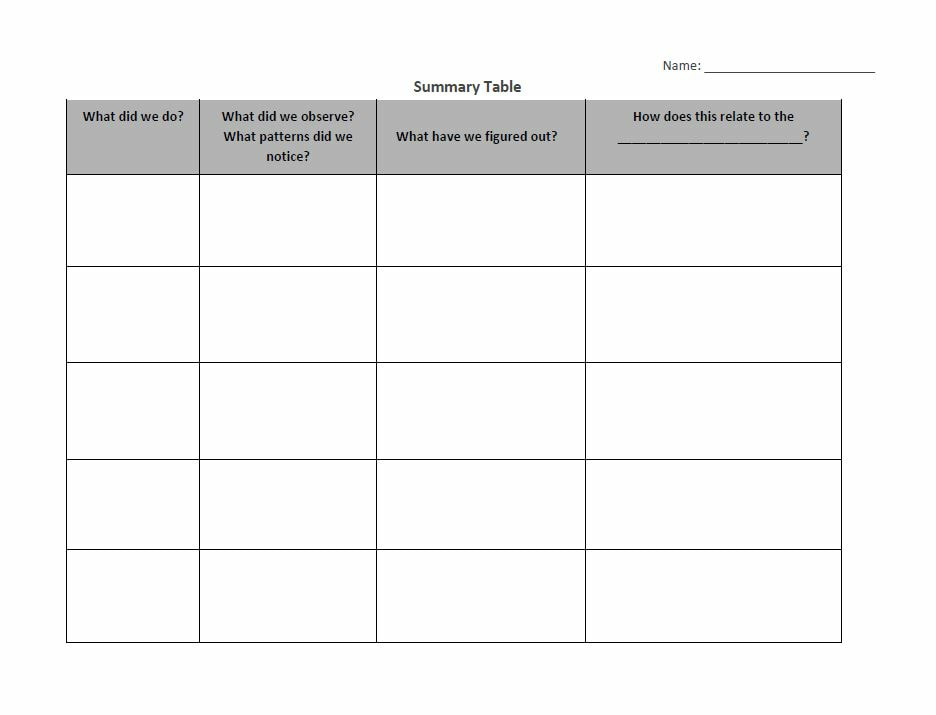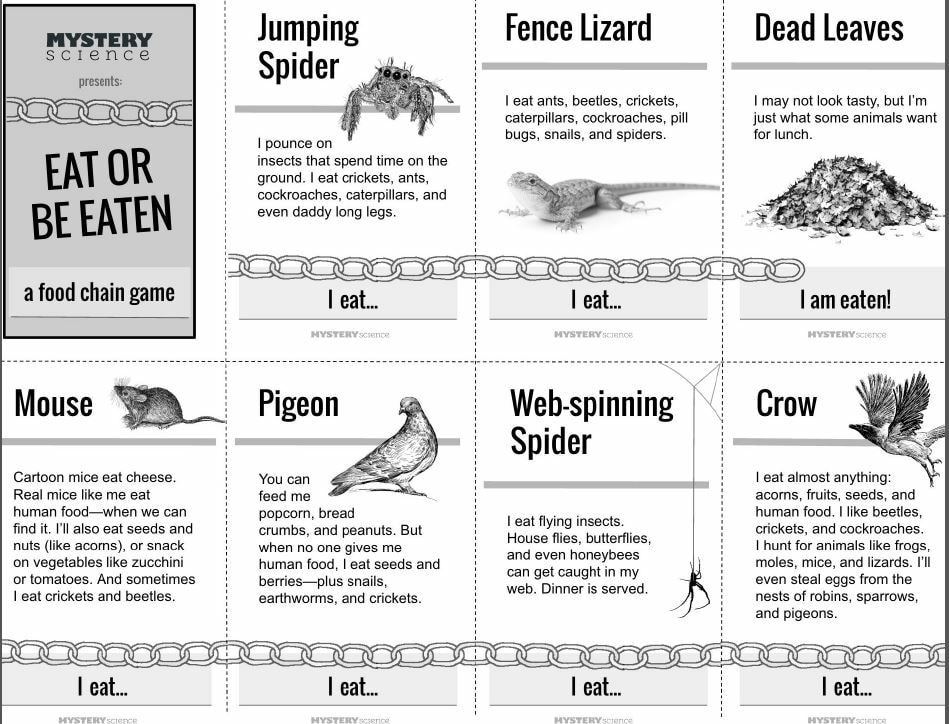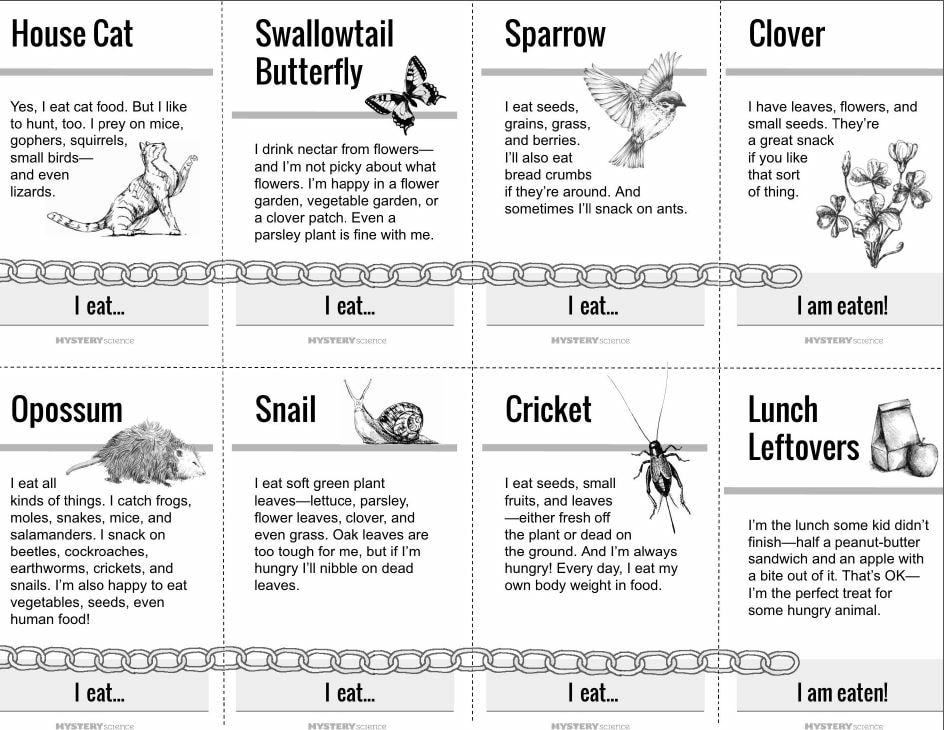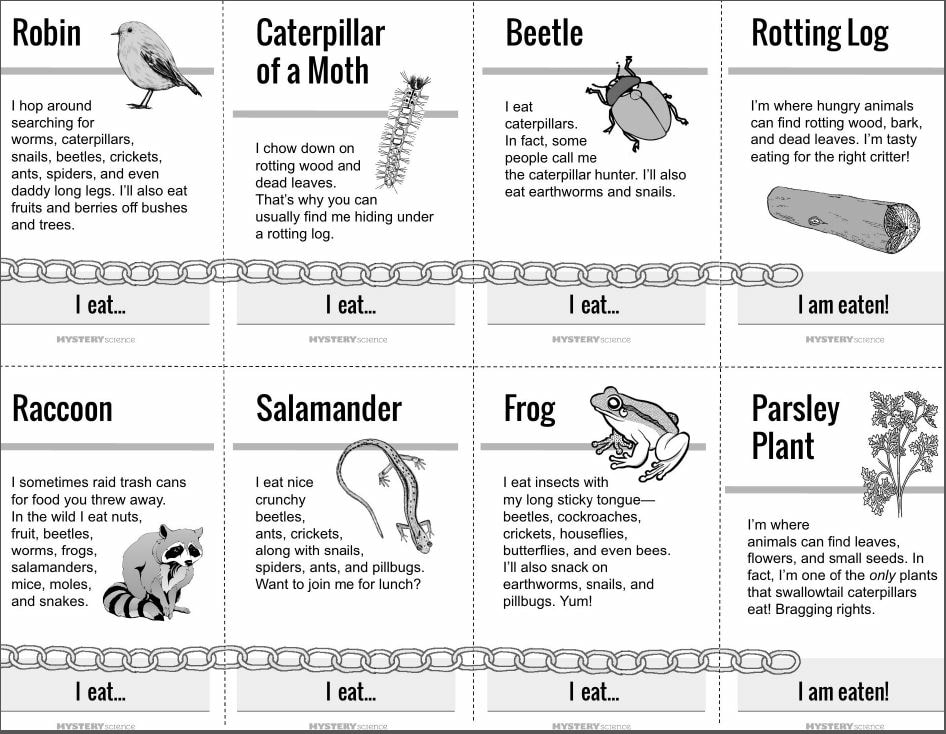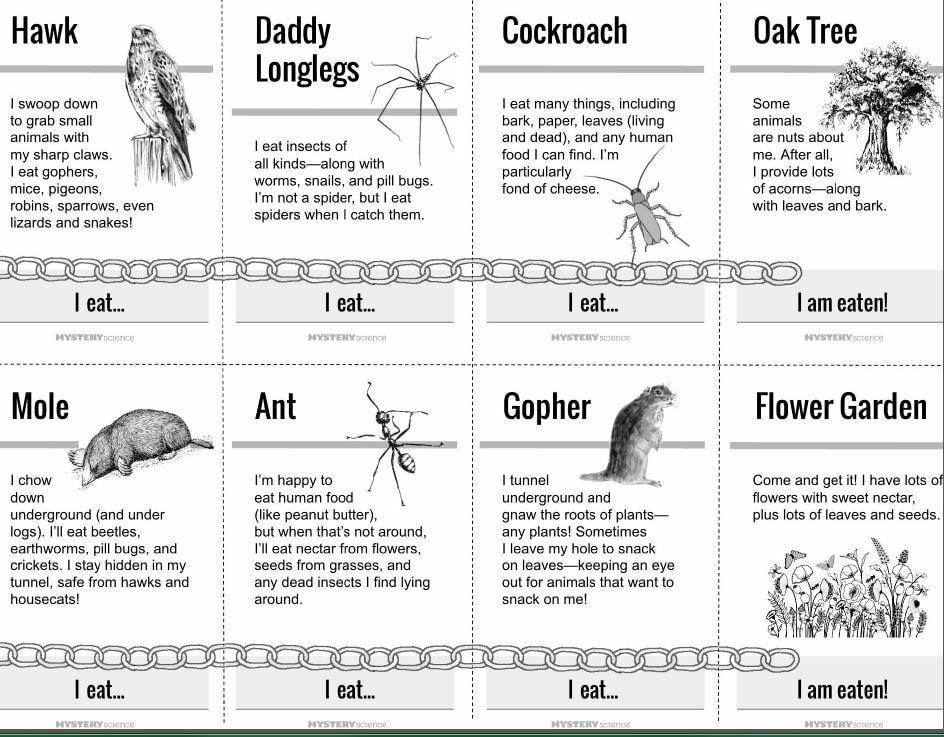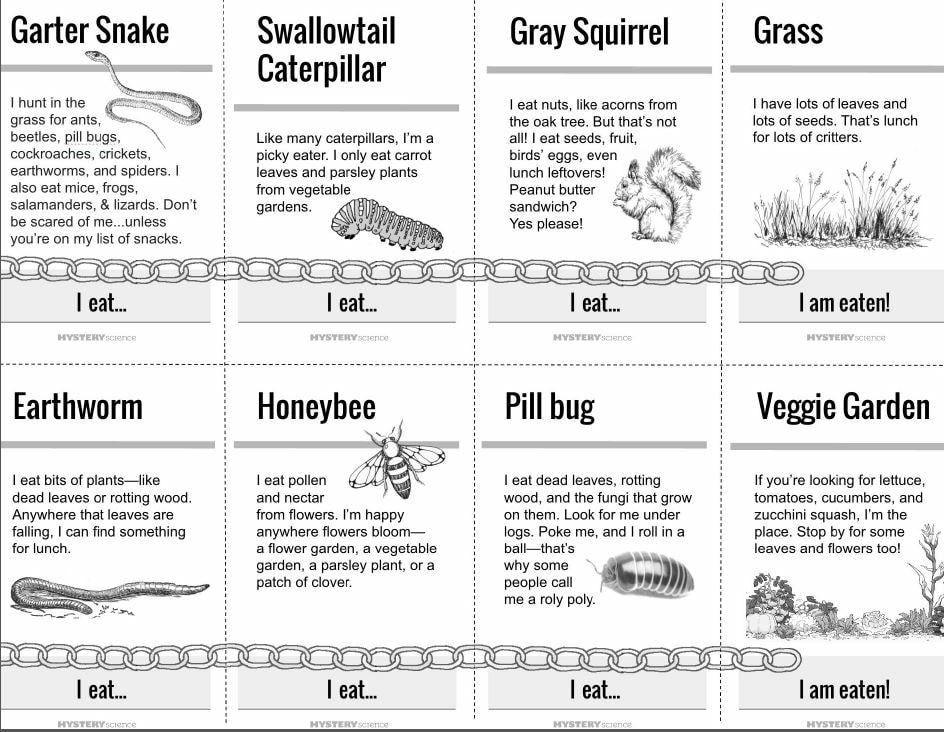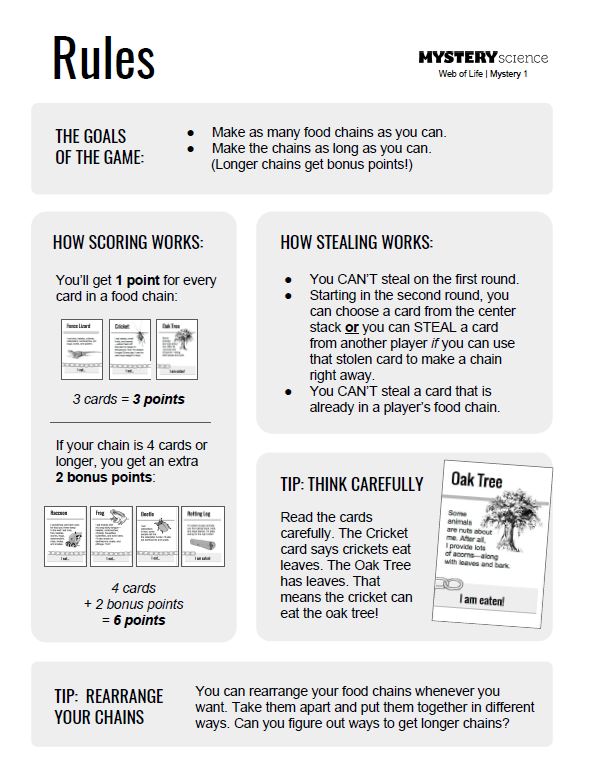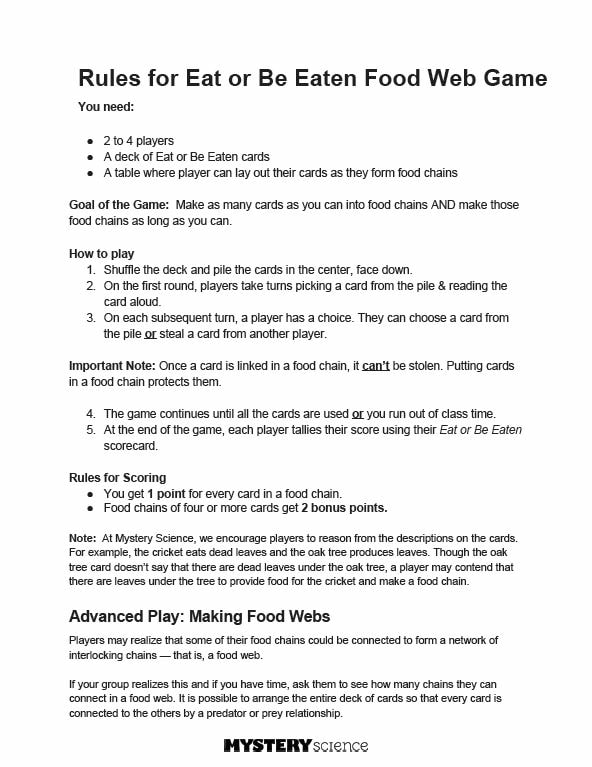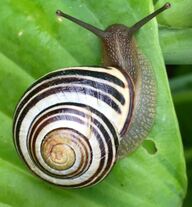
Food Chains and Food Webs
By Robin Crawford, Gardner Elementary School,
Email: Robin.Crawford(at)detroitk12.org
CLICK ON THE IMAGE TO DOWNLOAD A PRINTABLE VERSION OF THIS LESSON PLAN
By Robin Crawford, Gardner Elementary School,
Email: Robin.Crawford(at)detroitk12.org
CLICK ON THE IMAGE TO DOWNLOAD A PRINTABLE VERSION OF THIS LESSON PLAN
WE WOULD GREATLY APPRECIATE YOUR FEEDBACK! CLICK HERE TO COMPLETE A SHORT SURVEY TELLING US ABOUT YOUR EXPERIENCE WITH THIS LESSON PLAN.
Lesson Overview
Students will investigate how living organisms depend on one another for energy to survive. Students will learn about food chains and how energy is transferred from one living thing to another living thing. The teacher will use various resources to teach the concepts of food chains, food webs and how energy is transferred. Students will complete a Summary Table after each activity and discussion. In addition to the note-taking, students will view the video "Eat or Be Eaten” from the Mystery Science website. Students will read about what a food chain is and about the levels in a food chain, create a food chain showing levels of consumers, and play a food chain card game with pictures of consumers and producers. For final assessment, students will complete a flow chart showing energy being transferred from one living thing to another and write a paragraph describing what a food chain is and the role of a producer, each consumer and decomposer.
Teacher Background
Living things get their nutrients from food, which is how they get energy to breath, grow and move. A food chain shows how living things depend on other living things. It illustrates the flow of energy from one living thing to another. A food web displays how food chains are inter-connected in an ecosystem.
Materials Needed
• Technology: computer, smart board, KLEWS graphic organizer
• Inter-active workbook sheets,
• Science Journal
• Glue, scissors, crayons, pencil, paper
• Food chain game cards
• Food chain game score card
• Food chain game ‘How to Play’
• Food Chain game rules
• Wetland Food Chain book by Bobbie Kalman
• Mystery Science video to support the driving question: https://mysteryscience.com/ecosystems/ecosystems-the-food-web
• Summary Table for students to monitor their understanding of the concepts being taught, what they are still wondering about, and to help students organize their thoughts on paper.
References
Mystery Science: https://mysteryscience.com/ecosystems/ecosystems-the-food-web
Kalman, Bobbie. Wetland Food Chain. Crabtree Publishing Co. www.crabtreebooks.com
5th grade Inter-active science workbook teacher pay teacher (attached to the lesson plan)
Target Grade/Subject: 5th grade; Life Science
Setting: classroom
Advance preparation: pre-cut food chain cards.
Learning Objectives:
Students will be able to:
• explain what a food chain is,
• describe how energy is transferred,
• create several food chains and show how they can be inter-connected.
• describe how they’d fit into a food chain in a model or in writing.
Michigan Science Standards
Matter and Energy in Organisms and Ecosystems
5-PS3-1 Use models to describe that energy in animals’ food (used for body repair, growth, motion, and to maintain body warmth) was once energy from the sun.
5-LS2-1 Develop a model to describe the movement of matter among plants, animals, and the environment.
SEP: Science & Engineering Practices
Developing and using models, obtaining, evaluating and communicating information
Engaging in argument from evidence
DCI: Disciplinary Core Ideas
PS3-Energy
LS2: Ecosystems: Interactions, Energy, Dynamics
CCC: Cross-Cutting Concepts
4. Systems and System Models
5. Energy and Mater: Flows, cycles and conservation
Driving question: How do living things depend on other living things for food?
Engage: Day 1
1. Pass out the Summary Table graphic organizers (students will use this to record their responses, thoughts and wonders on this sheet after each activity)
2. Place the driving question on a large board (poster board). Students write their responses on sticky notes that will be posted on the driving question board.
3. Use the responses to guide the class discussions. Students will add some of the responses to their Summary table.
4. Read pages 8-11 from the book, Wetland Food Chains. Then introduce the vocabulary words, nutrients, producer, consumer,
herbivores, omnivores carnivores, primary, secondary and tertiary consumer to the class as he/she reads the book.
5. Write the definition for each word on the board.
6. Students copy the vocabulary and draw a picture or write an example of each.
Explore: Day 2
7. Review the driving question board and the sticky notes of questions and ideas.
8. Show the video, "Eat or be Eaten”, from Mystery of Science. Use the prompts for short discussions.
9. After the video, students talk about what they learned about food chains and use evidence from the video to support their statement (record their responses on the Summary table).
10. Have the students explain why the hawk chose to live in the city instead of a grassy plain.
11. Use the following questions to facilitate discussion about what students observed in the video and how it relates to the driving
question:
• What drove the hawks to live in the city?
• What needs to be present for an animal to live in an area?
• What evidence can you use from the video to support your statement?
Students will complete another row of their summary table: activity, what they observed, what they figured out and how is it related to the driving question. Students will share out what they learned.
Elaborate: Day 3 “Food Chain Game”
1. Review the driving question board, and the students will share what they know about what a living thing needs to survive. 5-minutes
2. Have the students review the vocabulary from day 1. 5 minutes
3. Pass out the materials for the food chain game and read over the rules of the game. Students will work in groups of four.
4. Students will create food chains using the game cards and record their models on their game sheet. Students will create a food web using the different food chains. 20 minutes
(Support and clarifying details: TW have the students share the different chains they created. Teacher will have the students label each consumer in their food chain.)
Evaluate: Day 4
Informative Evaluation: Students will cut and paste pre-printed animals and plants onto construction paper. Students will label each part of the food chain correctly: producer, energy, and primary, secondary, tertiary consumer.
Formative Evaluation: Students will explain what a food chain is in their own words, create a food chain and model how different food
chains connect to make a food web.
Teacher will assess the student’s food chain explanation to make sure that they mention transfer of energy, and that animals eat other animals for nourishment and energy. Students should start each food chain with a producer, and include three consumers.
Vocabulary: producer, consumer, primary, secondary, tertiary, food chain, food web (see p. 8-11 in Wetland Food Chain book)
Materials
Students will investigate how living organisms depend on one another for energy to survive. Students will learn about food chains and how energy is transferred from one living thing to another living thing. The teacher will use various resources to teach the concepts of food chains, food webs and how energy is transferred. Students will complete a Summary Table after each activity and discussion. In addition to the note-taking, students will view the video "Eat or Be Eaten” from the Mystery Science website. Students will read about what a food chain is and about the levels in a food chain, create a food chain showing levels of consumers, and play a food chain card game with pictures of consumers and producers. For final assessment, students will complete a flow chart showing energy being transferred from one living thing to another and write a paragraph describing what a food chain is and the role of a producer, each consumer and decomposer.
Teacher Background
Living things get their nutrients from food, which is how they get energy to breath, grow and move. A food chain shows how living things depend on other living things. It illustrates the flow of energy from one living thing to another. A food web displays how food chains are inter-connected in an ecosystem.
Materials Needed
• Technology: computer, smart board, KLEWS graphic organizer
• Inter-active workbook sheets,
• Science Journal
• Glue, scissors, crayons, pencil, paper
• Food chain game cards
• Food chain game score card
• Food chain game ‘How to Play’
• Food Chain game rules
• Wetland Food Chain book by Bobbie Kalman
• Mystery Science video to support the driving question: https://mysteryscience.com/ecosystems/ecosystems-the-food-web
• Summary Table for students to monitor their understanding of the concepts being taught, what they are still wondering about, and to help students organize their thoughts on paper.
References
Mystery Science: https://mysteryscience.com/ecosystems/ecosystems-the-food-web
Kalman, Bobbie. Wetland Food Chain. Crabtree Publishing Co. www.crabtreebooks.com
5th grade Inter-active science workbook teacher pay teacher (attached to the lesson plan)
Target Grade/Subject: 5th grade; Life Science
Setting: classroom
Advance preparation: pre-cut food chain cards.
Learning Objectives:
Students will be able to:
• explain what a food chain is,
• describe how energy is transferred,
• create several food chains and show how they can be inter-connected.
• describe how they’d fit into a food chain in a model or in writing.
Michigan Science Standards
Matter and Energy in Organisms and Ecosystems
5-PS3-1 Use models to describe that energy in animals’ food (used for body repair, growth, motion, and to maintain body warmth) was once energy from the sun.
5-LS2-1 Develop a model to describe the movement of matter among plants, animals, and the environment.
SEP: Science & Engineering Practices
Developing and using models, obtaining, evaluating and communicating information
Engaging in argument from evidence
DCI: Disciplinary Core Ideas
PS3-Energy
LS2: Ecosystems: Interactions, Energy, Dynamics
CCC: Cross-Cutting Concepts
4. Systems and System Models
5. Energy and Mater: Flows, cycles and conservation
Driving question: How do living things depend on other living things for food?
Engage: Day 1
1. Pass out the Summary Table graphic organizers (students will use this to record their responses, thoughts and wonders on this sheet after each activity)
2. Place the driving question on a large board (poster board). Students write their responses on sticky notes that will be posted on the driving question board.
3. Use the responses to guide the class discussions. Students will add some of the responses to their Summary table.
4. Read pages 8-11 from the book, Wetland Food Chains. Then introduce the vocabulary words, nutrients, producer, consumer,
herbivores, omnivores carnivores, primary, secondary and tertiary consumer to the class as he/she reads the book.
5. Write the definition for each word on the board.
6. Students copy the vocabulary and draw a picture or write an example of each.
Explore: Day 2
7. Review the driving question board and the sticky notes of questions and ideas.
8. Show the video, "Eat or be Eaten”, from Mystery of Science. Use the prompts for short discussions.
9. After the video, students talk about what they learned about food chains and use evidence from the video to support their statement (record their responses on the Summary table).
10. Have the students explain why the hawk chose to live in the city instead of a grassy plain.
11. Use the following questions to facilitate discussion about what students observed in the video and how it relates to the driving
question:
• What drove the hawks to live in the city?
• What needs to be present for an animal to live in an area?
• What evidence can you use from the video to support your statement?
Students will complete another row of their summary table: activity, what they observed, what they figured out and how is it related to the driving question. Students will share out what they learned.
Elaborate: Day 3 “Food Chain Game”
1. Review the driving question board, and the students will share what they know about what a living thing needs to survive. 5-minutes
2. Have the students review the vocabulary from day 1. 5 minutes
3. Pass out the materials for the food chain game and read over the rules of the game. Students will work in groups of four.
4. Students will create food chains using the game cards and record their models on their game sheet. Students will create a food web using the different food chains. 20 minutes
(Support and clarifying details: TW have the students share the different chains they created. Teacher will have the students label each consumer in their food chain.)
Evaluate: Day 4
Informative Evaluation: Students will cut and paste pre-printed animals and plants onto construction paper. Students will label each part of the food chain correctly: producer, energy, and primary, secondary, tertiary consumer.
Formative Evaluation: Students will explain what a food chain is in their own words, create a food chain and model how different food
chains connect to make a food web.
Teacher will assess the student’s food chain explanation to make sure that they mention transfer of energy, and that animals eat other animals for nourishment and energy. Students should start each food chain with a producer, and include three consumers.
Vocabulary: producer, consumer, primary, secondary, tertiary, food chain, food web (see p. 8-11 in Wetland Food Chain book)
Materials

New lesson plan ideas are welcome and will be uploaded as they are received and approved.
Instructions for submitting lesson plans for:
About invasive species,
About science and science careers
For information about submitting new lesson plans, please contact jchadde(at)mtu.edu
Lesson plan ideas from other web sites:
From Pennsylvania Sea Grant: 10 lesson plans about interactions of invasive species, biodiversity, and climate change
Creation of the above page of educational resources was funded in part by the Michigan Invasive Species Grant Program through the Departments of Natural Resources, Environmental Quality, and Agricultural and Rural Development.
This material is also based upon work supported by the National Science Foundation under Grant No. 1614187.
Any opinions, findings, and conclusions or recommendations expressed in this material are those of the authors and do not necessarily reflect the views of the National Science Foundation.
